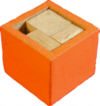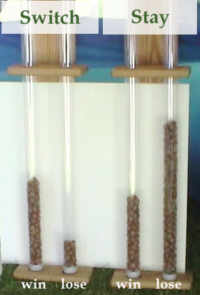 |
"The Cantankerous Cube" -- Its solution can be tenaciously
elusive, especially for the puzzle solver who plunges in without
first thinking it through.
It illustrates power in simple math. |
 |
It's a simpler version of the above make-a-cube puzzle. While the above puzzle resolutely resists trial and error, this one fairly easily submits to trial and error It is simply six 1X1X2 blocks that fit into a 3X3X3 box with three empty little cubes left unfilled. (The original also has three 1X1X1 blocks.) |
 |
"The Deceptive Cube," a fiendish variation of The Mikusinsky Cube.
Hugo Steinhaus, in his "Mathematical Snapshots" (a must for any serious
puzzler solver), describes this modification of the Soma Cube as the most
difficult of such puzzles. This version is a magician's super-devious
modification of the Mikusinski original.
This
puzzle must be experienced to be understood.
THE SECRET REVEALED |
 |
Martin Gardner's "Buzz Saw Cube," from his "Mathematical Games" feature
in Scientific American. It's elegant solution makes it a great
exemplar for logical imperative: it demonstrates "buzz
saw certainty."
See it in the original "Eureka!" page from Knowledge for Use: |
 |
This, too came from Martin Gardner's "Mathematical Games" feature in Scientific American. Gardner has recommended this puzzle and the Buzz Saw Cube as good places to start to demonstrate the power of mathematical reasoning. |
  |
Arrange the objects so that similarity and proximity
correlate. The closer two objects are, the more similar they are,
and the more similar, the closer. The objects can alternatively be
a large collection of paint samples: the sought for principle is the same.
This was a group of puzzles used to set the stage for a discussion of
information theory, entropy, energy, and thermodynamics. They also
focused on problems of logical contradiction.
|
 |
Oregonians for Rationalty presented the Monty Hall problem at Da Vinci Days in both 2002 and 2003. The results were the same in both years and demonstrated some of the opacity (magic) of statistical reasoning. The answer to this problem of statistical reasoning is demonstrated by the statistics shown in those tubes. Very few noticed. |
 |
This puzzle is sometimes solved by children while their parents look on baffled. The task is to cut a 3X5 card with a pair of scissors and then fold the cut card into this shape. |
 |
This puzzle is from Martin Gardner's "April Fool" set of Mathematical Games puzzles. Questions 2, 3, 4, and 10 on the page linked here are from that set. |
 |
Think first. Ask questions later. The puzzles are simple.
The puzzles are subtle. Discovering why "simple but subtle" is not
an oxymoron is a valuable step on your wonder-filled journey toward science-see.
"Let your mind dance to the abstract rhythms that human eyes and ears do
not sense."
This page from Da Vinci Days, 2002 is a good place to start: "MIND
DANCING INTO MAGIC"
Warning: "What's Up" gives clues. |
 |
These were handouts used in O4R's 2001 Da Vinci Days booth. The large sheet presented several kinds of puzzles: |
 |
Here are several scientific concepts which are widely known and often perceived as some of the substance of science. But each has its problems. Some are correct statements but are persistently misunderstood. Some are simply wrong. Some aren't even wrong. |